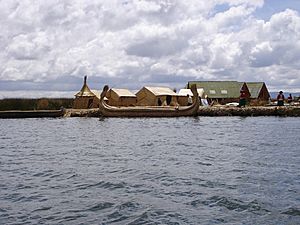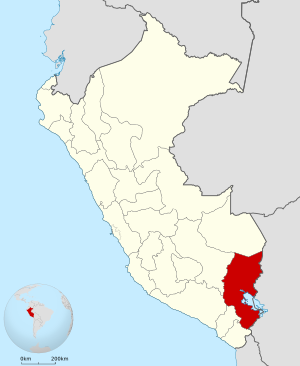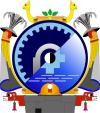Department of Puno facts for kids
Quick facts for kids
Department of Puno
|
|||
|---|---|---|---|

Lake Titicaca, which is partly located in the Puno Region
|
|||
|
|||

Location of the Puno Region in Peru
|
|||
| Country | Peru | ||
| Subdivisions | 13 provinces and 108 districts | ||
| Capital | Puno | ||
| Area | |||
| • Total | 66,997 km2 (25,868 sq mi) | ||
| Population
(2017)
|
|||
| • Total | 1,172,697 | ||
| • Density | 17.50372/km2 (45.3344/sq mi) | ||
| UBIGEO |
21
|
||
| Dialing code | 0+51 | ||
| ISO 3166 code | PE-PUN | ||
| Principal resources | Quinoa; it is also the nation's largest producer of potatoes, sheep, alpacas and llamas. | ||
| Poverty rate | 60.8% (INEI 2009) | ||
| Percentage of Peru's GDP | 2.3% | ||
| Website | www.regionpuno.gob.pe | ||
Puno is a region in southeastern Peru. It's the fifth biggest region in Peru. It shares borders with Bolivia to the east. Other Peruvian regions like Madre de Dios, Cusco, Arequipa, Moquegua, and Tacna are also nearby.
The capital city is Puno, found right on the shores of Lake Titicaca. This area is part of the Altiplano, a high plateau. Long ago, Puno was home to the Tiahuanacos people. They were an important part of the Aymara people culture. Later, the Incas took over these lands. The Spanish arrived next, interested in the region's mining. They left behind many historic buildings.
Contents
Geography of Puno: Mountains, Lakes, and Rainforests
The Puno region is mostly located on the Collao Plateau. This high flat land is very unique. A big part of Lake Titicaca is found here. Lake Titicaca is famous for being the highest lake in the world where boats can travel.
About 70% of Puno is covered by the Andean mountains. The rest of the region is part of the Amazon rainforest.
Islands of Lake Titicaca
Lake Titicaca has many islands. People living on these islands still follow old traditions. For example, the Uros people live on "floating islands." They build these islands themselves using totora reeds. They also make their traditional boats from these reeds.
Other islands like Taquile, Suasi, and Amantaní are known for their friendly people. These islanders are skilled in weaving, creating beautiful textiles. You can also find ancient buildings and lovely scenery there. The Titicaca National Reserve is a protected area. It helps keep the totora reeds safe, along with many plants and animals.
Climate and Water in Puno
The climate in the high plateau areas is cold and dry. It has a rainy season that lasts about four months. However, the climate in the rainforest part of Puno is warm.
Puno gets its water from Lake Titicaca. There are also about 50 other lagoons and over 300 rivers. The region also has a lot of water underground.
Political Divisions: How Puno is Organized
The Puno region is split into 13 main areas called provinces. These provinces are then divided into 107 smaller areas called districts. Each province has its own capital city.
Here are the provinces and their capital cities:
- Azángaro (Azángaro)
- Carabaya (Macusani)
- Chucuito (Juli)
- El Collao (Ilave)
- Huancané (Huancané)
- Lampa (Lampa)
- Melgar (Ayaviri)
- Moho (Moho)
- Puno (Puno)
- San Antonio de Putina (Putina)
- Sandia (Sandia)
- San Román (Juliaca)
- Yunguyo (Yunguyo)
History of the Puno Region
Long, long ago, the Collao plateau was home to groups of Aymara people. These included the Collas, Zapanas, Kallahuayos, and Lupacas. Later, the Quechuas arrived.
An old story says that Manco Cápac and Mama Ocllo came out of Lake Titicaca. They went on to start the great Inca Empire. The Aymara culture, also known as Putina, was very important in this region before the Spanish arrived.
Puno During Spanish Rule
During the time of Spanish rule, Puno was a key stop for travelers going to Potosí, a famous mining city in Bolivia. In 1668, a Spanish leader named Conde de Lemos made San Juan Bautista de Puno the capital of the Paucarcolla province. Later, it was renamed San Carlos de Puno to honor the Spanish king, Charles II of Spain.
In 1870, a railway line was built connecting Arequipa to Puno. This also marked the start of boat travel on Lake Titicaca.
In 2007, a meteorite landed in the region. This event caused some health concerns among local people. Scientists are still studying the exact reasons for these issues.
Languages and People of Puno
Most people in the Puno region are indigenous. As of 2011, about 41.4% of Puno's residents speak Quechua. Another 30.39% speak Aymara. A smaller number speak other indigenous languages. About 28.1% of the population only speak Spanish.
The most common Quechua language spoken in Puno is called Cusco–Collao Quechua.
Tourism in Puno
Tourism is growing in the Puno Region. Many tour companies and hotels are available. You can find everything from budget-friendly hostels to fancy hotels. Visitors come to explore the unique culture, history, and natural beauty of the area, especially Lake Titicaca and its islands.
See also
 In Spanish: Departamento de Puno para niños
In Spanish: Departamento de Puno para niños





